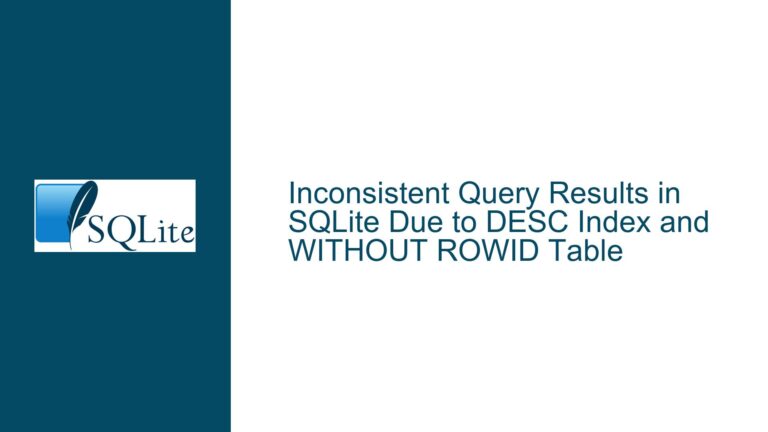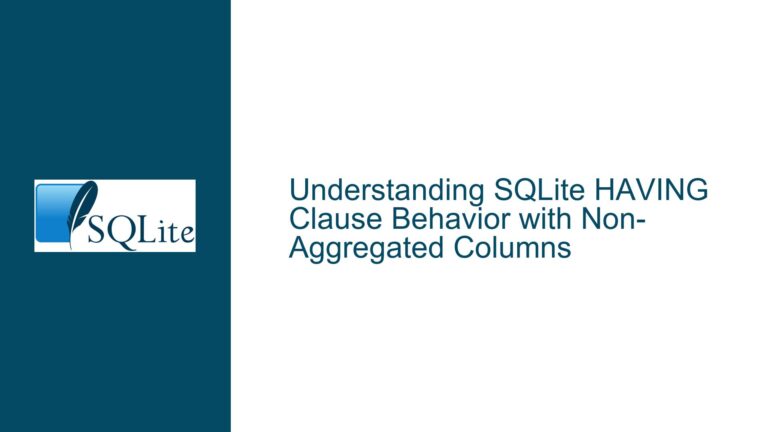SQLite GROUP BY Result Order Behavior Change in Version 3.28.0+
Ambiguous GROUP BY Queries and Result Order Inconsistencies
The behavior of SQLite’s GROUP BY clause has undergone a subtle but significant change starting with version 3.28.0, particularly affecting the order of results when non-aggregated columns are included in the SELECT statement. This change has caused confusion among developers who rely on the implicit behavior of earlier SQLite versions, where the order of results appeared consistent even when the query was technically ambiguous. The issue manifests when queries include columns in the SELECT clause that are not part of the GROUP BY clause or aggregate functions. In such cases, SQLite is free to choose any row from the group to represent the non-aggregated columns, and this choice can vary between versions or even between executions of the same query.
For example, consider a table myTable with the following structure and data:
| _id | year | command | code |
|---|---|---|---|
| 1 | 2005 | TV | A |
| 2 | 2005 | TV-CD | B |
| 3 | 2005 | CD | B |
| 4 | 2010 | TV | B |
| 5 | 2015 | TV | C |
Running the query SELECT * FROM myTable GROUP BY command ORDER BY _id DESC in SQLite 3.22 or 3.23.1 yields:
| _id | year | command | code |
|---|---|---|---|
| 2 | 2005 | TV-CD | B |
| 3 | 2005 | CD | B |
| 5 | 2015 | TV | C |
However, the same query in SQLite 3.28.0 or later produces:
| _id | year | command | code |
|---|---|---|---|
| 1 | 2005 | TV | A |
| 2 | 2005 | TV-CD | B |
| 3 | 2005 | CD | B |
This discrepancy arises because the query is ambiguous. The GROUP BY clause groups rows by the command column, but the SELECT statement includes non-aggregated columns (_id, year, and code) that are not part of the GROUP BY clause. SQLite is free to choose any row within each group to represent these columns, and this choice can vary depending on the version or even the execution context.
Implicit Row Selection and Version-Specific Behavior
The root cause of the issue lies in how SQLite handles non-aggregated columns in GROUP BY queries. In earlier versions of SQLite, the database engine would often select the first row encountered in each group to represent the non-aggregated columns. This behavior, while not guaranteed, was consistent enough that many developers came to rely on it. However, starting with SQLite 3.28.0, the engine’s internal optimizations and query execution plans changed, leading to different row selection behavior within groups.
This change is not a bug but rather a consequence of SQLite’s design philosophy, which emphasizes flexibility and performance. SQLite does not enforce strict rules for selecting rows in ambiguous GROUP BY queries, allowing the engine to optimize query execution based on the underlying data and available indexes. As a result, the same query can produce different results across versions or even between executions if the database engine decides to use a different execution plan.
The ambiguity in the query SELECT * FROM myTable GROUP BY command ORDER BY _id DESC stems from the fact that the SELECT clause includes columns that are not part of the GROUP BY clause or aggregate functions. SQLite does not guarantee which row’s values will be used for these columns, and the engine is free to choose any row within each group. This behavior is consistent with the SQL standard, which explicitly states that non-aggregated columns in a GROUP BY query are undefined unless they are functionally dependent on the grouped columns.
Resolving Ambiguity with Explicit Aggregation
To ensure consistent results across all versions of SQLite, developers must eliminate ambiguity in their GROUP BY queries. This can be achieved by explicitly specifying how non-aggregated columns should be handled using aggregate functions. For example, the query can be rewritten to use the MAX function to select the maximum _id within each group:
SELECT MAX(_id) AS _id, year, command, code
FROM myTable
GROUP BY command
ORDER BY _id DESC;
This query guarantees that the row with the maximum _id within each group is selected, ensuring consistent results regardless of the SQLite version or execution context. The use of aggregate functions like MAX, MIN, or AVG removes ambiguity by explicitly defining how non-aggregated columns should be handled.
In cases where developers need to select specific rows based on additional criteria, they can use subqueries or window functions. For example, the following query uses a subquery to select the row with the maximum _id for each command:
SELECT _id, year, command, code
FROM myTable
WHERE _id IN (
SELECT MAX(_id)
FROM myTable
GROUP BY command
)
ORDER BY _id DESC;
This approach ensures that the correct row is selected for each group, eliminating any ambiguity in the result set. By explicitly defining the selection criteria, developers can avoid relying on implicit behavior that may change between SQLite versions.
Best Practices for GROUP BY Queries in SQLite
To avoid issues with result order and ambiguity in GROUP BY queries, developers should adhere to the following best practices:
Explicitly Specify Aggregation: Always use aggregate functions for non-grouped columns in
GROUP BYqueries. This ensures that the query is unambiguous and produces consistent results across all versions of SQLite.Avoid Implicit Row Selection: Do not rely on SQLite’s implicit behavior for selecting rows in
GROUP BYqueries. Instead, use explicit criteria such asMAX,MIN, or subqueries to define which row should be selected.Test Across Versions: When upgrading SQLite or deploying applications to different environments, test
GROUP BYqueries to ensure consistent behavior. Use tools like JDoodle to test queries across multiple SQLite versions.Document Query Assumptions: Clearly document any assumptions about query behavior in the codebase. This helps other developers understand the intended behavior and avoid introducing changes that could lead to inconsistencies.
Use Window Functions for Complex Queries: For more complex queries that require selecting specific rows within groups, consider using window functions. These functions provide greater control over row selection and can simplify query logic.
By following these best practices, developers can ensure that their GROUP BY queries are robust, unambiguous, and consistent across all versions of SQLite. This approach not only avoids issues with result order but also makes the codebase more maintainable and easier to understand.
Conclusion
The change in GROUP BY behavior starting with SQLite 3.28.0 highlights the importance of writing unambiguous queries and avoiding reliance on implicit database behavior. By explicitly specifying how non-aggregated columns should be handled and testing queries across versions, developers can ensure consistent and reliable results. The use of aggregate functions, subqueries, and window functions provides the necessary tools to eliminate ambiguity and maintain control over query execution. Adopting these best practices will help developers avoid issues with result order and build more robust applications on top of SQLite.






